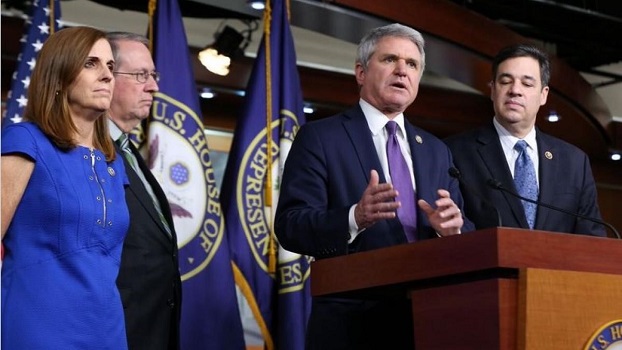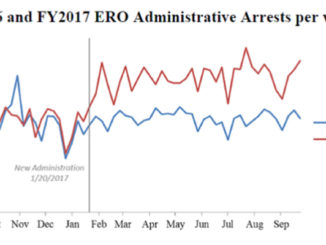
by David Bier
President Trump is backing the Securing America’s Future (SAF) Act drafted by key House Republicans. The SAF Act is a comprehensive immigration reform bill posing as a DACA fix. It is 414 pages long and touches on every major area of the immigration system—family, employment, and diversity legal immigration, humanitarian programs, workplace enforcement, temporary visas, interior enforcement, border security, criminal penalties, and much else. Comprehensive immigration reform is fine, but this massive, complex bill expands the scope of the debate so far from DACA that it cannot seriously be considered an answer to this relatively small immigration issue.
In any case, SAF’s negative provisions outweigh its positive ones. The good leaves much to be desired, and the bad is about as bad as it gets.
Positive Provisions
DACA recipients receive a nonimmigrant status that can be renewed indefinitely (p. 384). The failure to grant them permanent residency with a pathway to citizenship refuses to recognize them for what they are: Americans. But it is still better than the Senate Republican proposal that would grant just a three-year visa that is not renewable, and SAF would also allow them to adjust to permanent residency if sponsored by an employer. This is good, but because the bill does nothing about the per-country limits, sponsorship will just end up creating a huge backlog for green cards for Mexican workers, like the H-1B has for Indian workers. The bill also fails to allow legal immigrant Dreamers—the children of H-1Bs in temporary statuses—to apply for the provisional status, requiring all applicants to have violated the law, which is also an issue with DACA and other bills.
Nonetheless, legal status would allow Dreamers to increase their earnings and encourage them to invest in skills that benefit the United States. Keeping the immigrants here will benefit taxpayers because they will pay more in taxes than they receive in benefits over their lifetimes.
The bill’s guest worker program for 500,000 agricultural workers would reduce illegal immigration while providing a source of legal labor for farms (p. 22). I have previously explained and praised this specific proposal here. Still, the fact that the bill fails to provide any work visas for other industries is a shortcoming.
The 55,000 new employment-based green cards will benefit the economy and provide some small relief for skilled immigrants waiting in the decades-long backlog for green cards (p. 21). It also allows children of green card applicants to remain in line until they are 25 (p. 7), partially resolving the problem of “aging out” for some young immigrants—a phenomenon I’ve written about here. Increasing the number of CBP officers to screen travelers at ports of entry (p. 319) and modernizing ports of entry (p. 350) are overdue changes and benefit the economy by easing trade with Mexico and Canada. From a fiscal standpoint, giving parents of U.S. citizens nonimmigrant visas without the opportunity to obtain federal benefits instead of green cards is positive, but the bill senselessly bans the parents from working.
Negative Provisions
By far the worst aspect of the SAF Act are the cuts to legal immigration overall (pp. 5-21). The bill authors claim that it would cut immigration by 25 percent—some 2.6 million people per decade—but in reality, it would be closer to 430,000, almost a 40 percent decline. This would be the largest policy-driven reduction in legal immigration since the awful, racially motivated acts of the 1920s.
SAF also changes asylum law to make it more difficult for asylum seekers to apply by greatly increasing the standard of proof to apply for asylum (p. 23). I have previously written about how these changes will make it virtually impossible for asylum seekers who don’t already have attorneys waiting for them and evidence gathered to prove their claims to even apply for asylum.
The worst enforcement provision is criminalizing simply being in the United States without status or violating any aspect of civil immigration law (p. 170). This would turn millions of unauthorized immigrants into criminals overnight. It would also criminalize legal immigrants who fail to update their addresses, carry their green card with them at all times, or otherwise abide by the million inane regulations that Congress imposes on them. Take, for example, the status provided to Dreamers in this bill. It requires them to maintain an annual income of at least 125 percent of the poverty line (p. 396). If they fall below that level for 90 days—not only are they subject to deportation again—they would be criminals. This bill literally criminalizes poverty among Dreamers. This legislation would immediately undo much of the progress that the Feds have made on criminal justice reform and reducing its prison population.
Several other security provisions are also problematic. Mandatory E-Verify (p. 87) will impose massive regulatory costs on small businesses, establish a federal national identification system that includes all U.S. workers, and cause hundreds of thousands of Americans to have their jobs delayed or lost entirely due to database errors—all while having a track record of failure in every state that has tried to use it to prevent illegal employment. My detailed comments on this specific E-Verify proposal are here.
Biometric exit (p. 356) is a multi-billion dollar boondoggle that would add absolutely nothing to security while imposing huge costs of travelers and intruding into Americans privacy. Increasing the number of Border Patrol agents by 25% at a time when each agent is already catching less than two crossers per month makes no sense (p. 319). Authorizing states to use the National Guard along the border on the U.S. taxpayer dime is another proven waste of money (p. 286)—even Border Patrol says so.
The bill authorizes spending of $124 billion over five years on border security alone (p. 348). The bill makes little effort to find a means to pay for this gargantuan sum. For comparison, the entire Border Patrol budget last year was $3.8 billion.
An infeasible trade
Republicans are essentially asking Democrats to trade the legalization of 700,000 unauthorized immigrants for the criminalization of all others, banning 2.6 million legal immigrants over the next decade, the elimination of almost all family sponsorship preference categories and the diversity visa lottery, deporting tens of thousands of asylum seekers, huge increases in border security spending, a massive new regulatory program that applies to every employee and employer in the country (“E-Verify”), and so much else. This bill has no chance of becoming law, but it is a remarkable illustration of how far apart the parties are on this issue.
David J. Bier is an immigration policy analyst at the Cato Institute’s Center for Global Liberty and Prosperity.



